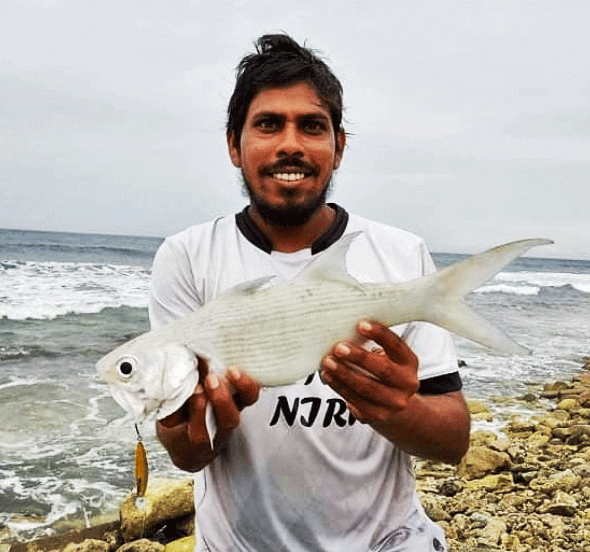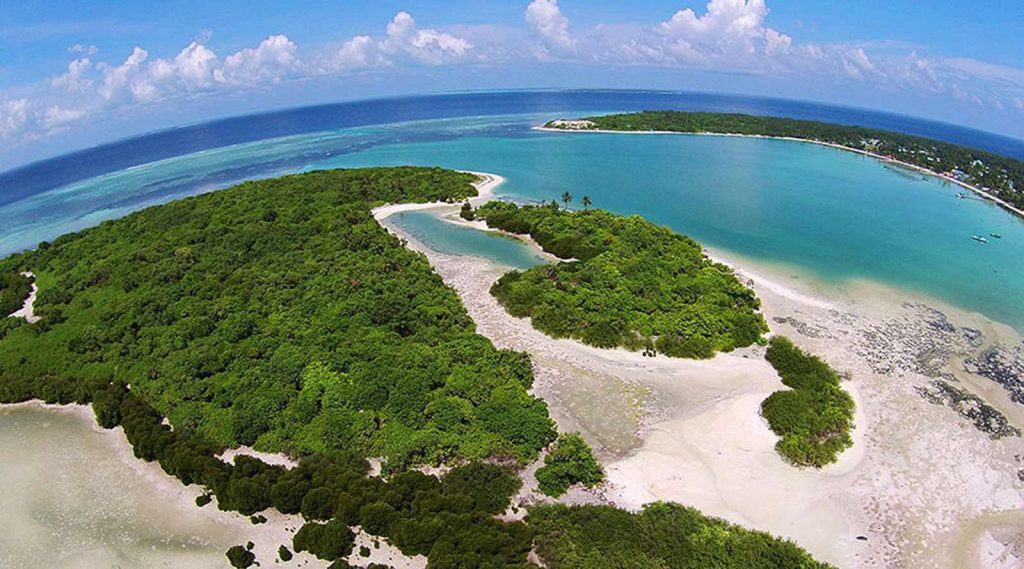
As children, we assumed few fish could live in saltwater and freshwater. The barred flagtail fish, also known as kashifulhu, is one such species. I caught this fish with my father at low tide on the reef flat. He caught small fish using his sarong, known as mundu in our dialect. We store them in saltwater and add freshwater to dilute it. We put flagtails in the household well after they’ve adapted to freshwater, called dhefenedhiriun.
Indo pacofic tarpon (Megalops cyprinoides) is another freshwater-saltwater fish inhabiting the Maldivian waters. I considered listing every mangrove and wetland freshwater fish. I called one of my friends from Baarah Island, Bilal (we call him Bille), about this. I inquired about his island’s diverse fish species. An interesting fish that lives in the mangroves of Baarah Island, he told me, is the Indo-Pacific turpon. “We used to land this fish with small Rapalas and silicone lures.”
This species appealed to me due to my familiarity with flagtail and milkfish. The fact that I also use ultralight casting methods to catch fish on the reef and reef front made this already interesting even more so.
Its scientific name is Megalops cyprinoides Broussonet (1782). Many parts of the world refer to this fish as oxeye herring or Indo-Pacific tarpon. Megalops atlanticus is a relative of this fish. It is called Alanku in India, Indo Pacific Tarpon in Australia, Hairen, Isegoi in Japan, Ileya, Mareva in Sri Lanka, and Abulong, Buan-buan in the Philippines. 2019 (Khairul, Machrizal, Harahap, Gultom, Nazliah, n.d.)
This fish’s mouth is big. They primarily consume shrimp and terrestrial insects. Only sometimes do they eat smaller fish, crabs, and plants. Prawns, herring, and other tiny fish are their major diet in salt water. When they are in freshwater, their eating habits don’t change much; they mostly eat freshwater shrimp and bony bream. Maldives waters have predominantly juveniles.
Indo-Pacific tarpon live in marine environments and have freshwater juveniles. This species likely reproduces at sea. In some parts of the world, tarpon is a famous game fish. They weigh 18 kg and reach 150 cm.
Their natural habitat includes coastal waterways, estuaries, and freshwater rivers and lakes. They are amphidromous, which means that they migrate from the river to the sea and from the sea to the river. Many juveniles move up river mouths and may live their whole lives in freshwater bodies of water, but adults are more often found in the ocean.
Baarah Island mangroves are frequent hosts of this fish. Some fishermen like catching this fish. Juvenile tarpon thrives on Baarah Island’s mangrove, which flows into the sea. Minnow and silicone lures are used by anglers. They land this fish with ultra-light gear. Small, colorful lures help them land fish.
This fish is easy to catch with jigs, soft plastics, and tiny poppers. In many cases, they will bite at little jigs. Their big eyes sit high on their heads, and their mouths slant upwards. That makes it easy for them to sneak up on prey above them. Retrieve the bait from the middle to upper water column to maximize your chances of catching.
Soft plastic jerk baits and swimbaits that are three inches long or less are some of the best lures for young tarpon. An easy way to set these up is on a bass worm hook. But It is better to thread them onto a J-hook with a straight shank and leave the hook point visible. Lightweight jigs are also useful, as are narrow profile plugs like floating diving minnow plugs or twitch baits. All of these lures should be less than three inches long, and the plugs should have single hooks instead of treble hooks for better hits (Macinnis, n.d.).
